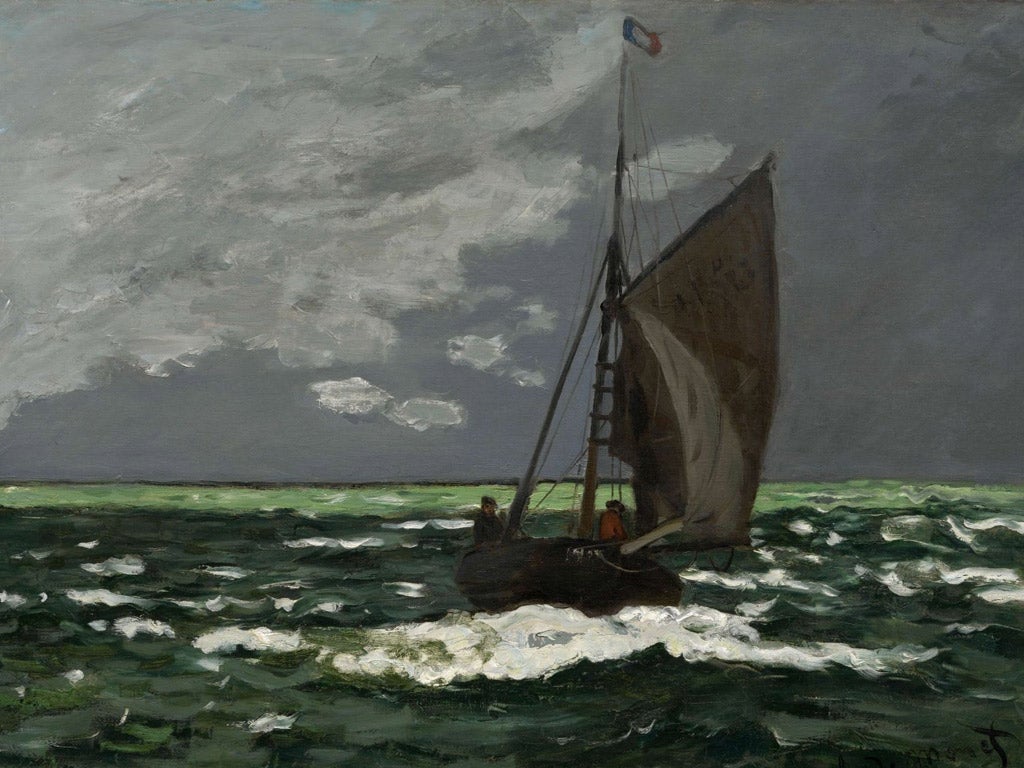From Paris: A Taste for Impressionism, Royal Academy, London
The heirs to the Singer sewing-machine fortune bought whatever they damn well liked

The most intriguing objects in the Royal Academy's new loan show from the Clark Institute in Massachusetts are arguably not the ones on the walls – Monets, Manets, Renoirs, et cetera – but the ones in glass cases.
Laid out for everyone to see are receipts for the paintings bought by Sterling Clark, joint heir to the Singer sewing-machine fortune, in the years from 1916 to 1956 – the core of the collection that now bears his name beside that of his wife, Francine. The inclusion of this paperwork seems faintly improper, somehow, suggesting as it does that the lovely (or sometimes unlovely) pictures on the walls nearby boil down to mere financial transactions, goods ordered and paid for in dollars and cents.
We are not usually encouraged to think about painting in this hard-nosed way, although it is sometimes important that we should. To understand the art of the Medici, it helps to have seen their contracts with Fra Angelico. But you do wonder if this hang has been meted out to the Clarks because they were American – whether on show alongside the receipts in the Academy's vitrines is the tired, old idea of dollar millionaires having more money than taste, being five-star buyers of art by the yard.
This cliché is certainly not borne out by the Clark collection, its quirkiness suggesting an eye that was a good deal more passionate than calculating. If Sterling's enthusiasm for Renoirs was unhappily shared by other US collectors – the 39 he bought pale beside the 181 stockpiled by Alfred Barnes in Philadelphia – his habit of buying untypical paintings by typical painters makes you forgive him.
Any old millionaire might have snapped up Geese in the Brook in 1949, this having been painted within weeks of the first Impressionist exhibition and so about as blue-chip as a Monet could be. But why, three years later, did Clark instruct his dealer, Knoedler, to spend rather more – $16,500, as against $12,500 – on Monet's pre-Impressionist Street in Sainte-Adresse (1867)? Certainly not with an eye to return on capital.
The most likely answer is that, as the show's signage mildly puts it, he and Francine "preferred subject matter that was suitable for their house". (Latterly a vast flat at 740 Park Avenue, New York, known as "the world's richest apartment building"). Which is a way of saying that the Clarks bought what they damn well liked, always a good thing in a collection.
This also explains another oddball work, Seascape: Storm, clearly made when Monet had been looking over Manet's shoulder at Boulogne. So, too, Renoir's Sunset, an almost-likeable (and so unusual) riposte to Monet's Impression: Sunrise. The Clarks' own taste also suggests how one room of genre paintings in this generically-organised show can have a stunning wall of Degas, Lautrecs and Manets facing another of Renoirs and Tissots, a luminous Bonnard across from a Giovanni Boldini. This mix-and-match arrangement reaches its climax in the last and best room. Were there not dozens of other reasons to see From Paris, then the Clarks' early Degas self-portrait, modern and Dutch, would be reason enough.
So is this show anything more than a medley of quirky, pretty pictures, a handy summer filler for the Sackler Galleries? It is certainly both of those things, but it is something else as well.
Any collection is more than the sum of its parts. Sterling and Francine Clark's is a portrait of the couple themselves, of a moment in the history of taste, and collecting in the history of art. Which is to say that the Clark Collection is both an amalgam of artworks and an artwork itself, a thing to be kept together and preserved. And so it is. The reason that the paintings are on their current world tour is that the museum building the Clarks built to house them in 1955 is being renovated.
Unfortunately, this has not been the fate of all great American collections. Alfred Barnes – he of the 181 Renoirs – also built a museum to house his collection: a rather more ambitious one than the Clarks', as it happens, with Cubist bas-reliefs by Jacques Lipchitz and a mural by Henri Matisse. The vast number of works crammed into this sort-of-Palladian villa in suburban Philadelphia – 69 Cézannes, 46 Picassos, 11 Degas – were hung according to Barnes's idiosyncratic ideas on art, while Mrs Barnes landscaped the gardens. After years of nasty manoeuvring by the city's political elite, the Barnes Collection was stripped from the physician's museum and moved to a dull modern building downtown. The new Barnes Foundation (sic) opened in May. Philadelphians should hang their heads.
To 23 September (020-7300 8000)
Critic's Choice
There's much more to Edvard Munch than The Scream, as Tate Modern’s latest show uncovers. At the Baltic in Gateshead, Mark Wallinger makes witty attempts to bring order to the world: organising pebbles on a giant checkerboard and “marking” every brick of a large stone wall, in his large-scale pieces entitled Site. Both till 14 Oct.
Subscribe to Independent Premium to bookmark this article
Want to bookmark your favourite articles and stories to read or reference later? Start your Independent Premium subscription today.

Join our commenting forum
Join thought-provoking conversations, follow other Independent readers and see their replies